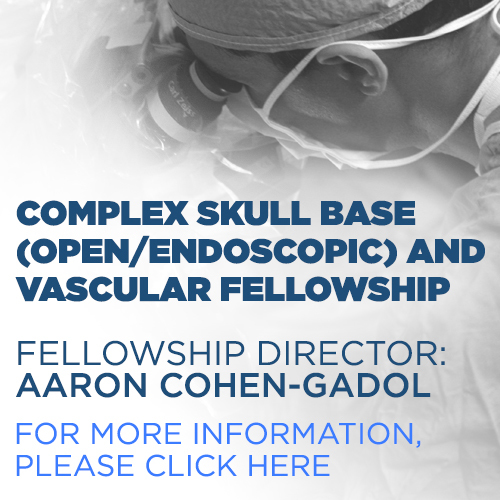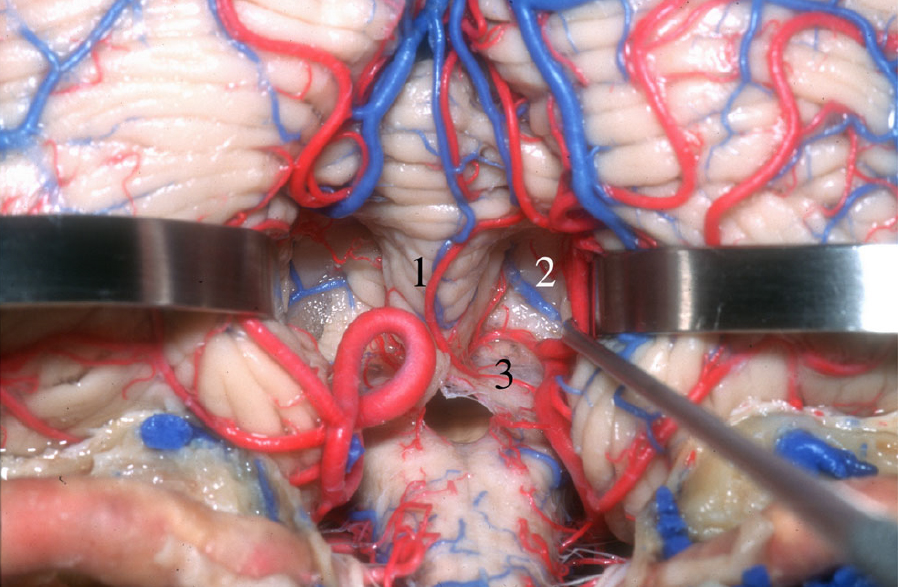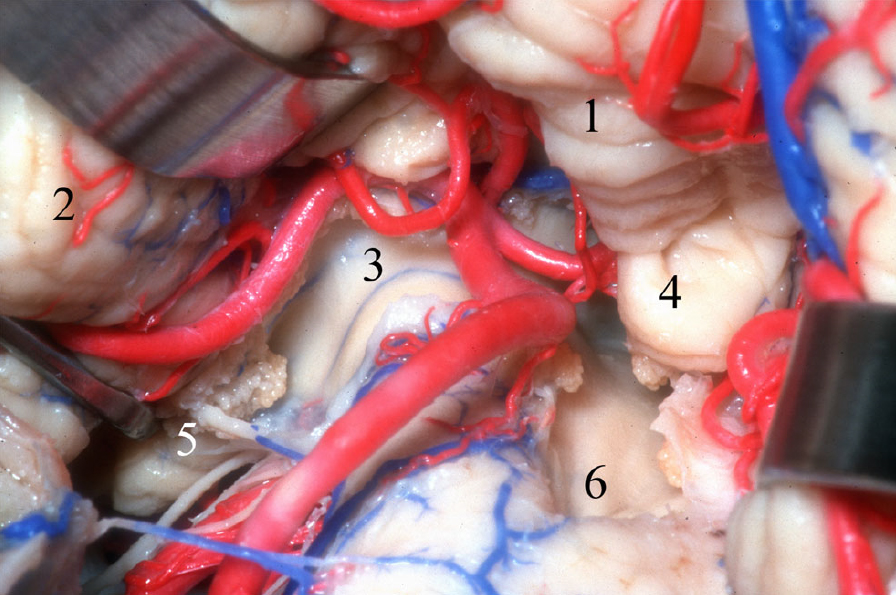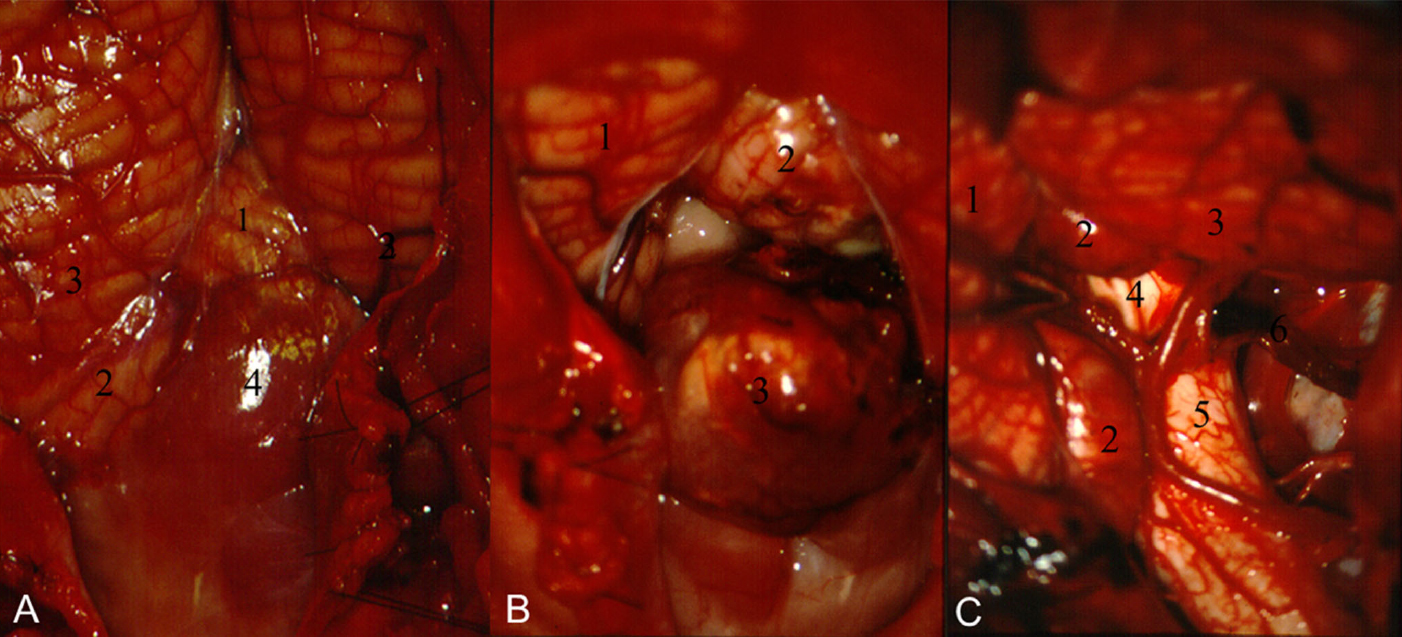Fourth Ventricle Approaches
ABSTRACT
PURPOSE: Knowledge of anatomy of the IV ventricle is basic to surgical approach of any kind of lesion in its compartment as well as for those located in its neighborhood. The purpose of this study is to demonstrate the surgical approach options for the IV ventricle, based on the step by step dissection of anatomical specimens.
METHODS: Fifty formalin-fixed specimens provided were the material for this study. The dissections were performed in the microsurgical laboratory in Gainesville, Florida, USA.
RESULTS: The IV ventricle in a midline sagittal cut shows a tent-shaped cavity with its roofs pointing posteriorly and the floor formed by the pons and the medulla. The superior roof is formed by the superior cerebellar peduncles laterally and the superior medullary velum on the midline. The inferior roof is formed by the tela choroidea, the velum medullary inferior, and the nodule. The floor of the IV ventricle has a rhomboid shape. The rostral two thirds are related to the pons, and the caudal one third is posterior to the medulla. The median sulcus divides the floor in symmetrical halves. The sulcus limitans runs laterally to the median sulcus, and the area between the two sulci is called the median eminence. The median eminence contains rounded prominence related to the cranial nucleus of facial, hypoglossal, and vagal nerves. The lateral recesses are extensions of the IV ventricle that opens into the cerebellopontine cistern. The cerebellomedullary fissure is a space between the cerebellum and the medulla and can be used as a surgical corridor to the IV ventricle.
CONCLUSIONS: We obtained in this study a didactic dissection of the different anatomical structures, whose recognition is important for addressing the IV ventricle lesions.
INTRODUCTION
The fourth ventricle is a midline cavity located between the brain stem and the cerebellum [1]. Surgical access to the fourth ventricle is obtained either by splitting the vermis, removing a part of the cerebellum, or dissecting the cerebellomedullary fissure [2–11]. Knowledge of the anatomy of the IV ventricle is required in order to choose the best approach for each particular lesion.
MATERIALS AND METHODS
Fifty formalin-fixed specimens provided were the material for this study. The arteries were perfused with red silicone and the veins with blue silicone. The dissections were performed to expose the fourth ventricle in a stepwise manner to simulate the surgical exposure that can be gained by opening the cerebellomedullary fissure, opening the tela choroidea and the inferior medullary velum, and opening the lateral recess and finally by removing the tonsil. The dissections were performed in the microsurgical laboratory in Gainesville, Florida (USA), under the supervision of Dr. Albert Rhoton Jr. and in several microsurgical anatomical courses.
Anatomy
A midline sagittal cut shows the fourth ventricle as a tent-shaped cavity with its roofs pointing posteriorly (Fig. 1). The floor of this tent-shaped cavity faces anteriorly, and it is formed by the pons and the medulla. The superior and inferior roofs meet at the fastigium [1, 8, 12].
Figure 1. The IV ventricle in a sagittal view resembles a tent with its apex, the fastigium, pointing posteriorly. 1 Tentorial surface of the cerebellum. 2 Superior roof of the IV ventricle, superior medullary velum. 3 Fastigium. 4 Floor of the IV ventricle: pons and medulla. 5 Lateral recess. 6 Inferior roof of the IV ventricle, tela choroidea. 7 Suboccipital surface of the cerebellum. (Image courtesy of AL Rhoton, Jr.)
The fourth ventricle connects with the third ventricle through the cerebral aqueduct, with the cisterna magna through the foramen of Magendie and with the cerebellopontine angles through the lateral recesses.
Superior Roof
The superior roof of the fourth ventricle is formed by thick neural structures: the superior cerebellar peduncles laterally and the superior medullary velum on the midline (Figs. 2 and 3). The superior medullary velum is located below the lingula, which is the most superior portion of the cerebellar vermis. The superior cerebellar peduncles are the continuation of the dentate nuclei. The dentate nucleus is located just above the superior pole of the tonsils.
Figure 2. Anterior view of the roof of the IV ventricle after removing the pons and the medulla. 1 Foramen of Luschka. 2 Pontomedullary sulcus. 3 Superior medullary velum. 4 Nodule. 5 Tela choroidea. (Image courtesy of AL Rhoton, Jr.)
Figure 3. Anterior view of the lateral recess. 1 Superior medullary velum. 2 Tela choroidea forming the floor of the lateral recess. 3 Nodule 4 Tela choroidea. (Image courtesy of AL Rhoton, Jr.)
Inferior Roof
The inferior roof is formed by the tela choroidea, the inferior medullary velum, and the nodule. The nodule is the most inferior portion of the cerebellar vermis (Figs. 2, 3, 4, 5, 6, and 7). The inferior medullary velum is the connection between the nodule and flocculus. The inferior medullary velum is a thin semilunar structure located just above the superior part of the tonsils. The inferior medullary velum extends from the nodule to the peduncle of the flocculus. The space between the inferior medullary velum inferiorly and the superior cerebellar peduncle superiorly is called the superolateral recess (Figs. 8, 9, and 10). The superolateral recesses are small projections of the fourth ventricle lateral to the nodule. The tela choroidea attaches to the inferior medullary velum and the nodule. The tela choroidea sweeps down from the telovelar junction to attach to the taenia on the inferolateral sides of the floor of the fourth ventricle. The tela choroidea extends laterally to form the floor of the lateral recesses. This lateral extension makes the tela choroidea resemble the letter T when seen from anterior (Fig. 3). The tela choroidea has an inferior opening, the foramen of Magendie, and two lateral openings of the lateral recesses, the foramina of Luschka.
Figure 4. Suboccipital surface of the cerebellum. 1 Biventral lobule 2 Tonsil and vallecula. 3 Cerebellomedullary fissure. (Image courtesy of AL Rhoton, Jr.)
Figure 5. The tonsil on the right side was removed. 1 Pyramid. 2 Tonsil. 3 Uvula. 4 Inferior medullary velum. 5 Tela choroidea. (Image courtesy of AL Rhoton, Jr.)
Figure 6. View of the inferior roof of the IV ventricle after removal of both tonsils. 1 Nodule. 2 Uvula. 3 Inferior medullary velum. 4 Tela choroidea at the level of the lateral recess. 5 Foramen of Magendie. (Image courtesy of AL Rhoton, Jr.)
Figure 7. View of the IV ventricle after removal of the tela choroidea. 1 Inferior medullary velum and telovelar junction. 2 Peduncular portion of the lateral recess. 3 Superior cerebellar peduncle. 4 Superior medullary velum. 5 Posterolateral recess between the superior cerebellar peduncle and the inferior medullary velum. 6 Dentate tubercle near the lateral recess. (Image courtesy of AL Rhoton, Jr.)
Figure 8. Coronal cut at the level of the dentate nucleus. 1 Inferior medullary velum. 2 Uvula. 3 Tonsil. 4 Dentate nucleus. (Image courtesy of AL Rhoton, Jr.)
Figure 9. Posterior view of the lateral recess. 1 Flocculus and peduncle of the flocculus. 2 Inferior medullary velum. 3 Nodule. 4 Posterolateral recess. 5 Lateral recess. (Image courtesy of AL Rhoton, Jr.)
Figure 10. Sagittal cut at the level of the dentate nucleus. 1 Superior cerebellar peduncle. 2 Dentate tubercle. 3 Inferior medullary velum. (Image courtesy of AL Rhoton, Jr.)
Floor
The floor of the fourth ventricle has a rhomboid shape (Fig. 11). The rostral two thirds of the floor are posterior to the pons, and the caudal one third is posterior to the medulla. The lateral recesses are related to the pontomedullary junction. The floor may be divided in three parts: superior or pontine part, intermediate or junctional part, and inferior or medullary part. The superior part is limited inferiorly by an imaginary line connecting the inferior margins of the cerebellar peduncles. The superior part is limited laterally by the superior cerebellar peduncles, and it continues superiorly with the cerebral aqueduct. The intermediate part extends into the lateral recesses. The inferior part is limited laterally by small ridges, the taenia, which meet inferiorly at the obex. The median sulcus divides the floor in symmetrical halves. The sulcus limitans runs laterally to the median sulcus, and the area between the two sulci is called the median eminence. The median eminence contains a rounded prominence, the facial colliculus and three triangular areas, the hypoglossal and vagal triangles and the area postrema. The sulcus limitans has two small dimples, the superior fovea and the inferior fovea. The superior fovea is lateral to the facial colliculus, and the inferior fovea is lateral to the hypoglossal triangle. The vestibular area is the portion of floor lateral to the sulcus limitans. The vestibular area is widest in the intermediate part of the floor, where it forms a rounded elevation that extends into the lateral recess. The striae medullaris cross the midportion of the floor.
Figure 11. Floor of the IV ventricle. 1 Middle cerebellar peduncle. 2 Inferior cerebellar peduncle. 3 Superior cerebellar peduncle. 4 Median sulcus. 5 Superior fovea lateral to the facial colliculus. 6 Inferior fovea lateral to the hypoglossal triangle. 7 Funiculus separans. 8 Obex. (Image courtesy of AL Rhoton, Jr.)
Lateral Recess
The lateral recesses are lateral extensions of the fourth ventricle that open through the foramina of Luschka into the cerebellopontine angle. The lateral recess may be divided into two portions: the peduncular and the floccular parts (Fig. 9) [1, 13]. The peduncular part is formed by the inferior cerebellar peduncle anteriorly and the peduncle of the flocculus posteriorly. The floccular part is formed by the rhomboid lip anteriorly and the flocculus posteriorly. The rhomboid lip is a sheet of neural tissue just posterior to the glossopharyngeal and vagal nerves. The floor of both portions of the lateral recess is formed by the tela choroidea.
Cerebellum
The suboccipital surface of the cerebellum is the one exposed in surgical approaches to the fourth ventricle. The inferior roof of the fourth ventricle is hidden by the inferior portion of the suboccipital surface of the cerebellum. The tonsil and the biventral lobule cover the tela choroidea and the lateral recess. The nodule is hidden by the uvula and the pyramid. The cerebellomedullary fissure is a natural space that can be used to gain access to the fourth ventricle with no resection of cerebellar structures. The cerebellomedullary fissure is the space between the cerebellum and the medulla. It is continuous with the vallecula, the space between the medial walls of each tonsil. The vallecula leads into the fourth ventricle. The tonsil is the structure that blocks most of the view of the inferior roof of the fourth ventricle. If the tonsil is removed, we have a direct view of the tela choroidea and the inferior medullary velum. Removing the tonsil and opening the tela choroidea and the inferior medullary velum expose the most inferior part of the superior cerebellar peduncle and the superolateral recess. The tonsil is attached to cerebellar hemisphere through the tonsillar peduncle, located at the superolateral portion of the tonsil.
Posterior Inferior Cerebellar Artery
The posterior inferior cerebellar artery (PICA) courses along the cerebellomedullary fissure near inferior roof of the fourth ventricle and supplies most of the suboccipital surface of the cerebellum (Fig. 9). The PICA may be divided into five segments [14–16]. The anterior medullary segment begins at the origin from the vertebral artery and extends until the most prominent part of the inferior olive. The lateral medullary segment is from the olive until the origin of the glossopharyngeal, vagus, and accessory rootlets. The tonsillomedullary segment extends from the origin of IX, X, and XI nerves to the dorsal aspect of the medulla, ascending until the midportion of the tonsil. The tonsillomedullary segment usually forms a caudal loop near the inferior pole of the tonsil. The telovelotonsillar segment begins at the midportion of the tonsil and ascends on the medial wall of the tonsil, usually forming a cranial loop near the inferior medullary velum. The last segment of the PICA is the cortical segment. The cortical segment supplies most of the suboccipital surface of the cerebellum. The PICA has perforating branches to the medulla and choroidal branches to the tela choroidea.
Approaches to the Fourth Ventricle
A common approach to the fourth ventricle consisted of splitting the vermis on the suboccipital surface of the cerebellum. This is the oldest and most widely used approach to the fourth ventricle. The incision on vermis extends a variable distance depending on the localization and size of the tumor, limiting it to the smallest possible length necessary to remove the lesion. This incision should have a superior limit on the inferior edge of the superior medullary velum, because the decussating fibers of the superior cerebellar peduncle lie deep in relation to this structure [1, 5]. Because of the concern for equilibratory disturbance and cerebellar mutism, other forms of access to the fourth ventricle have been proposed [17–22].
The telovelar approach takes advantage of the natural clefts of the cerebellomedullary fissure to expose the tela choroidea and the inferior medullary velum (Figs. 12, 13, and 14) [6–9]. Opening the tela choroidea gives access to the floor of the fourth ventricle from the obex to the cerebral aqueduct (Fig. 14). Exposure of the lateral recess can be achieved by dissecting the tonsil and retracting it laterally. Opening the tela choroidea forming the floor of the lateral recess provides a view of the lateral recess from the cerebellar peduncle to the foramen of Luschka (Figs. 15 and 16). Opening the tela choroidea requires coagulation of some choroidal branches of the PICA. The telovelar approach also exposes the superior medullary velum and the superior cerebellar peduncles. However, the posterolateral recess is the most difficult part to expose using the telovelar approach (Fig. 14).
Figure 12. Suboccipital surface of the cerebellum. 1 Vallecula. 2 Cerebellomedullary fissure. 3 vertebral artery. (Image courtesy of AL Rhoton, Jr.)
Figure 13. Dissection of the vallecula and cerebellomedullary fissure to expose the inferior roof of the IV ventricle. 1 Uvula. 2 Inferior medullary velum. 3 Tela choroidea. (Image courtesy of AL Rhoton, Jr.)
Figure 14. Opening of the tela choroidea. 1 Inferior medullary velum. 2 Nodule. 3 Superior cerebellar peduncle. 4 Superior medullary velum. 5 Floor of the IV ventricle exposed from the aqueduct to the obex. (Image courtesy of AL Rhoton, Jr.)
Figure 15. Retraction of the tonsil to expose the lateral recess on the left side. 1 Tonsil. 2 Tela choroidea on the floor of the lateral recess. (Image courtesy of AL Rhoton, Jr.)
Figure 16. Opening the tela choroidea exposes the lateral recess. 1 Uvula. 2 Tonsil. 3 Lateral recess, peduncular part. 4 Nodule. 5 Flocculus. 6 Obex. (Image courtesy of AL Rhoton, Jr.)
The tonsils block the view to the superolateral recess. If better exposure of the superolateral recess is needed, as in lesions near the confluence of the cerebellar peduncles, then, removal of the ipsilateral tonsil will provide a direct view of this area (Figs. 17, 18, and 19) The dentate nucleus is just above to superior pole of the tonsil, and care should be taken when removing lesions at the level of the superolateral recess in order not to damage the dentate nucleus. Removal of one tonsil provides the widest view of the fourth ventricle, including direct access to the ipsilateral lateral recess.
Figure 18. Removal of the tonsil better exposes the inferior medullary velum, the superolateral recess, and the region of the confluence of the cerebellar peduncles. 1 Inferior medullary velum. 2 Uvula. 3 Tonsil on the right side. (Image courtesy of AL Rhoton, Jr.)
Figure 19. Removal of the tonsil. a T2 coronal MRI showing a cavernoma at the confluence of the cerebellar peduncles. b The left tonsil is being retracted to show the tela choroidea at the level of the left lateral recess: 1 left tonsil, 2 uvula, 3 tela choroidea at the level of the lateral recess, and 4 right tonsil. c Final view after resection of the cavernoma: 1 Resection of the cavernoma, and 2 obex. d The left tonsil was removed to better expose the area of the confluence of the cerebellar peduncles: 1 superior cerebellar peduncle, 2 cerebral aqueduct, 3 median sulcus, and 4 resection of the cavernoma. (Images courtesy of AL Rhoton, Jr.)
Tumors inside the fourth ventricle usually expand through the cerebellomedullary fissure, providing a natural corridor for removal without the need to split the vermis or to remove the tonsil. Infratentorial ependymomas, considered as a IV ventricle tumor, usually have its epicenter just lateral to the inferior cerebellar peduncle, usually spreading more to the cerebellomedullary fissure than to the IV ventricle cavity. In cases where the tumor infiltrates the vermis, splitting the vermis is a natural way of removing these lesions. Infiltration of the vermis is more commonly found in medulloblastomas, due to their origin, from the germinal cell layer that migrate rostrally to form the external granular cells at the roof of the fourth ventricle. When tumors expand inside the IV ventricle, the tela choroidea is stretched and looks like a transparent membrane with the choroid plexus attached to the tumor (Figs. 20 and 21). In both the transvermian and telovelar approaches, there is an exposure of the entire floor of the fourth ventricle and the superior operative angle of approach was limited by the superior medullary velum in the sagittal plane.
Figure 20. Medulloblastoma of the IV ventricle. a 1 pyramid, 2 Tonsil, and 3 tumor and choroid plexus of the tela choroidea. b The tonsils were dissected and retracted laterally. 1 Vermis. 2 Tumor and choroid plexus of the tela choroidea. 3 Medulla. c Complete removal of the tumor with no damage to the vermis. 1 Median sulcus. 2 Obex. (Images courtesy of AL Rhoton, Jr.)
Figure 21. Infratentorial ependymoma. a. 1 vermis, 2 left tonsil, 3 biventral lobules, and 4 tumor filling the cisterna magna. b 1 vermis, 2 right tonsil, and 3 tumor dissected from the right tonsil. c Complete removal of the ependymoma, from the right cerebellomedullary fissure. 1. Vermis. 2. Tonsils. 3 Right biventral lobule. 4 IV Ventricle. 5 Medulla. 6. Cerebellomedullary fissure. (Images courtesy of AL Rhoton, Jr.)
CONCLUSION
Exposure of the floor of the fourth ventricle can be achieved with no damage to cerebellar structures by using the telovelar approach. The telovelar approach offers also a view of the superior roof of the fourth ventricle and the lateral recess. Splitting the vermis can be used if there is infiltration by the tumor. If exposure of the region of the superolateral recess and confluence of the cerebellar peduncles is needed, resection of the ipsilateral tonsil and part of the biventral lobule can provide a better and easier view.
Contributors: Antonio Cesar de Melo Mussi, Hamilton Matushita, Fernanda Gonçalves Andrade, and Albert L. Rhoton, Jr
Content from de Melo Mussi AC, Matushita H, Andrade FG, Rhoton AL, Jr. Surgical approaches to IV ventricle—anatomical study. Childs Nerv Syst 2015;31:1807–1814. doi.org/10.1007/s00381-015-2809-0.
The Neurosurgical Atlas is honored to maintain the legacy of Albert L. Rhoton, Jr, MD.
References
- Matsushima T, Rhoton AL, Lenkey C (1982) Microsurgery of the fourth ventricle: part I. Microsurgical anatomy. Neurosurgery 11:631–667
- Bricolo A, Turazzi S (1995) Surgery for gliomas and other mass lesions of the brainstem. Advances and technical standards in neurosurgery, vol. 22. Springer, Wien, pp 261–341
- Jean WC, Aziz KMA, Keller JT, Van Loveren HR (2003) Subtonsillar approach to the foramen of Luschka. Neurosurgery 52:860–866
- Kellog JX, Piatt JH Jr (1997) Resection of fourth ventricle tumors without splitting the vermis: the cerebellomedullary fissure approach. Pediatr Neurosurg 27:28–33
- Kempe LG (1970) Operative Neurosurgery, vol. 2. Springer, New York, 1–33
- Matsushima T, Fukui M, Inoue T, Natori Y, Baba T, Fujii K (1992) Microsurgical and magnetic resonance imaging anatomy of the cerebellomedullary fissure and its application during fourth ventricle surgery. Neurosurgery 30:325–330Matsushima T, Inoue T, Inamura T, Natori Y, Ikezaki K, Fukui M (2001) Transcerebellomedullary fissure approach with special reference to methods of dissecting the fissure. J Neurosurg 94:257–264
- Mussi ACM, Rhoton AL Jr (2000) Telovelar approach to the fourth ventricle: microsurgical anatomy. J Neurosurg 92:812–823
- Tamriover N,UlmAJ, Rhoton AL Jr, YasudaA (2004) Comparison of the transvermian and telovelar approaches to the fourth ventricle. J Neurosurg 101:484–498
- Yaşargil MG (1996) Microneurosurgery, vol. 4B. Thieme, New York, p 63–4
- Zyal IM, Sekhar LN, Salas E (1999) Subtonsillartranscerebellomedullary approach to lesions involving the fourth ventricle, the cerebellomedullary fissure and the lateral brainstem. Br J Neurosurg 13(3):276–284
- Matsushima T, Rhoton AL Jr, Oliveira E, Peace D (1983) Microsurgical anatomy of the veins of the posterior fossa. J Neurosurg 59:63–105
- Huang YP, Wolf BS (1967) The vein of the lateral recess of the fourth ventricle and its tributaries – Roentgen appearance and anatomic relationships. Am J Roentgenology Radium Ther Nucl Med 101:1–21
- Fujii K, Lenkey C, Rhoton AL Jr (1980) Microsurgical anatomy of the choroidal arteries: Fourth ventricle and the cerebellopontine angles. J Neurosurg 52:504–524
- Lister JR, Rhoton AL, Matsushima T, Peace D (1982) Microsurgical anatomy of the posterior inferior cerebellar artery. Neurosurgery 10:170–199
- Margolis MT, Newton TH (1974) The posterior inferior cerebellar artery. In: Newton TH, Potts DG. ed. Radiology of the skull and brain, vol. 2. C.V. Mosby, St. Louis, p 1710–74
- Aguiar PH, Plese JPP, Ciquini O, Marino R (1995) Transient mutism following a posterior fossa approach to the cerebellar tumors in children: a critical review of the literature. Child’s Nerv Syst 11:306–310
- Bastian AJ, Mink JW, Kaufman BA, Thach WT (1998) Posterior vermal split syndrome. Ann Neurol 44:601–610
- Dailey AT, MMckhann GM II, Berger MS (1995) The pathophysiology of oral pharyngeal apraxia and mutism following posterior fossa tumor resection in children. J Neurosurg 83:467–475
- Dietze DD Jr, Mickle JP (1990/1991) Cerebellar mutism after posterior fossa surgery. Pediatric Neurosurg. 16:25–31
- Pitsika M, Tsitouras V (2013) Cerebellar mutism. A review. J Neurosurg Pediatrics 12:604–614
- Pollack IF, Polinko P, Albright AL, Towbin R, Fitz C (1995) Mutism and pseudobulbar symptoms after resection of posterior fossa tumors in children: incidence and pathophysiology. Neurosurgery 37:885–893
Please login to post a comment.
































